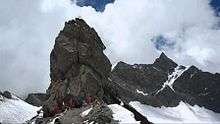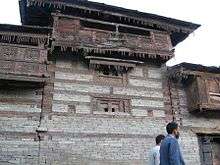Nirmand
| Nirmand Kashi of Himalayas | |
|---|---|
| Village | |
 Nirmand  Nirmand Location in Himachal Pradesh, India | |
| Coordinates: 31°25′59″N 77°34′59″E / 31.43306°N 77.58306°ECoordinates: 31°25′59″N 77°34′59″E / 31.43306°N 77.58306°E | |
| Country |
|
| State | Himachal Pradesh |
| District | Kullu |
| Area | |
| • Total | 2.5 km2 (1.0 sq mi) |
| Elevation | 1,576 m (5,171 ft) |
| Population (2011)[1] | |
| • Total | 6,593 |
| • Density | 2,600/km2 (6,800/sq mi) |
| Languages | |
| • Official | Hindi |
| Time zone | IST (UTC+5:30) |
| Vehicle registration | HP 35 |
| Sex ratio | 10:9.5?/? |
Nirmand is a village located in the taluk of Nirmand, of district Kullu, in the state of Himachal Pradesh of India. Nirmand is 2nd largest village in Himachal Pradesh, India and Name of Assembly Constituency. It is the headquarters of Nirmand subdivision and Nirmand Block of District Kullu of Himachal Pradesh.
Overlooking the Sutlej valley in the lesser-known Seraj region of Kullu district, and about 150 km from Shimla and 17 km from Rampur, is the large Nirmand village. This village has been in existence since the early Vedic period, making it one of the oldest rural settlements in India. A number of ancient stone and wooden temples dating back to the 6th and the 7th centuries A.D. speak of Nirmand’s religious and historical importance. For this reason it is often called the "Kashi of the Himalayas."
History
One of the ancient shrines in the village is dedicated to Goddess Ambika, the mother of Parshuram. Although the original structure has been altered, several old stone sculptures have been preserved in the temple complex. A unique feature of the temple is its roof, which is made of pure copper sheets. Another temple nearby, called Deccani Mahadev Temple, is dedicated to Lord Shiva. Its lingam is believed to have been brought from Deccan, and hence the name. The temple is renowned for its intricately carved wooden doors and pillars that are probably the finest examples of woodcarving in the state. Nirmand’s principal shrine, however, is the Parshuram temple complex, which is built in the traditional Pahari style with gabled slate roof and extensive use of wood and stone. The exterior wooden balconies and pillars are elaborately carved in folk style, depicting scenes from the Hindu mythology. The temple complex resembles a hill fortress, which encloses a small courtyard with the only entrance from the western side. The northern section of the temple is a double-storeyed structure, which houses the legendary bhandar (storehouse) that is believed to contain priceless artefacts of which little is known.
Access
- Distance from Shimla: 149 km
- Distance from Rampur: 17 km
- Distance from Kullu (main town): 237 km
- Distance from Manali: 243 km
Attractions
- Dakhini Mahadev Tample
- Ambika Mata Tample
- Akhara
- Shrikhand Peak[2]
- Baga Sarahan[3]
- Rampur Hydro Project[4]


References
External links
| Wikimedia Commons has media related to Nirmand. |
- Kashi of Himalya
- Shrikhand Mahadev Yatra
- Nirmand block at a Glance
- Buddhist Western Himalaya: A politico-religious history